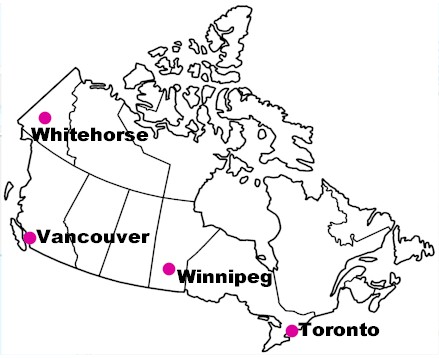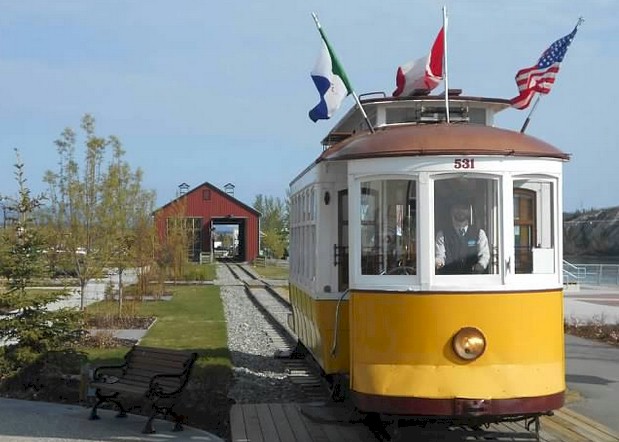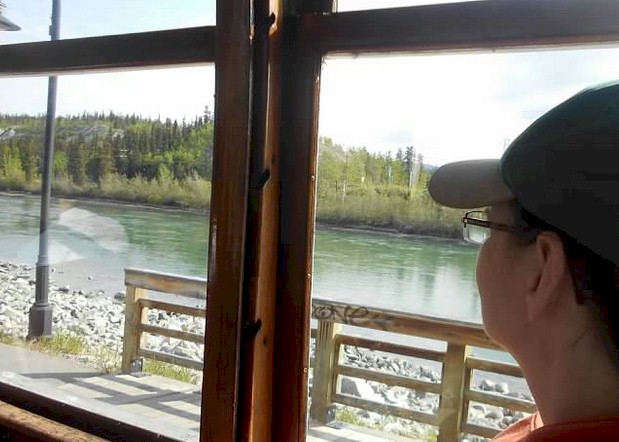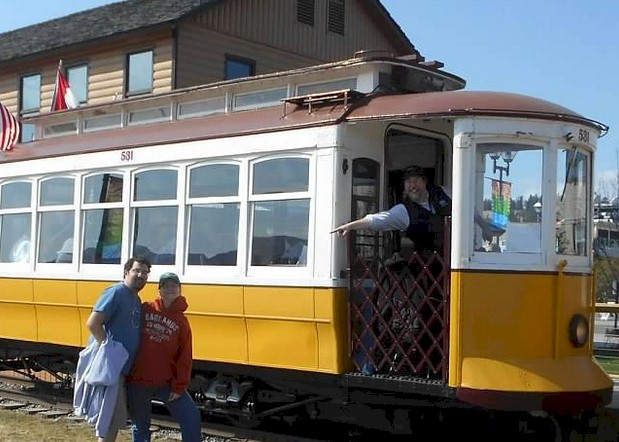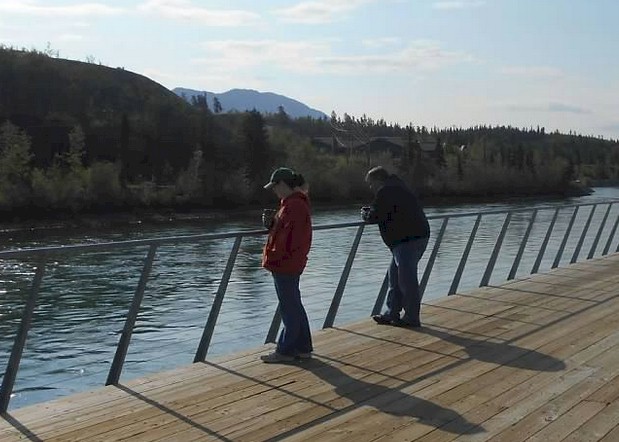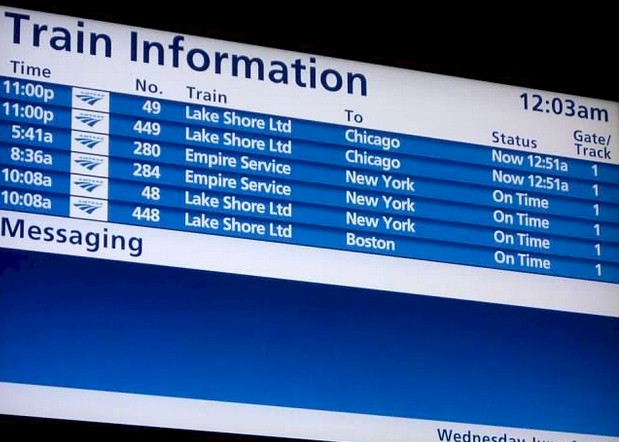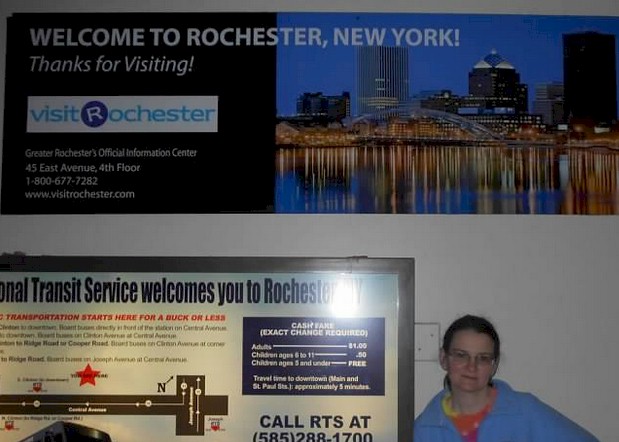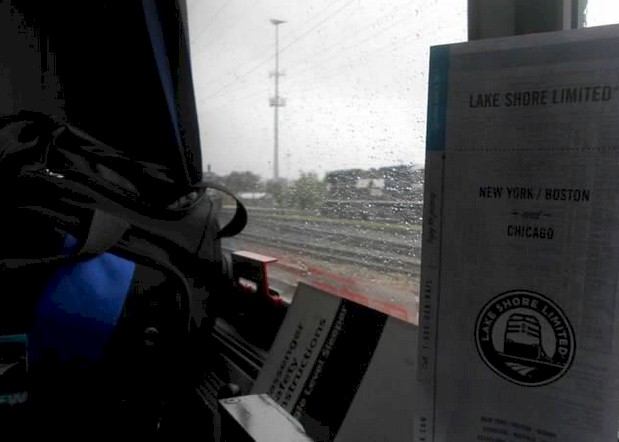We hope you enjoyed the two
articles that we wrote in previous months covering the first and second portions of our trip to
Alaska, the Yukon, and across Canada by rail. The first article (released in late January 2015) focused on the initial
four days of our journey, including time in Fairbanks, a road trip on the Dalton
Highway to the Arctic Circle, a day in Denali National Park, and a trip on the
Alaska Railroad between Fairbanks and Anchorage. The second article
(released in early March 2015) focused on our time in southeast Alaska,
through British Columbia, and into the
Yukon on the White Pass & Yukon Route Railroad. Finally, this
month's article (April 2015) will focus on the last few days of the
trip in Whitehorse, Vancouver, and on VIA’s Canadian from Vancouver to Toronto.
When
we last left you, we were staying in Whitehorse, Yukon, after arriving
from Skagway, Alaska on the White Pass & Yukon Route. Early the
next morning we had some spare time to explore around Whitehorse before
our flight to Vancouver. Stops included checking out the old White Pass
& Yukon Route station in Whitehorse. You will note in our second
article that we mentioned the White Pass & Yukon originally went all the way from Skagway, Alaska to Whitehorse, Yukon.
However, the usable track today is just from Skagway, Alaska to
Carcoss, Yukon. The station still exists in Whitehorse and there is
talk about restoring the right-of-way between Carcross and Whitehorse.
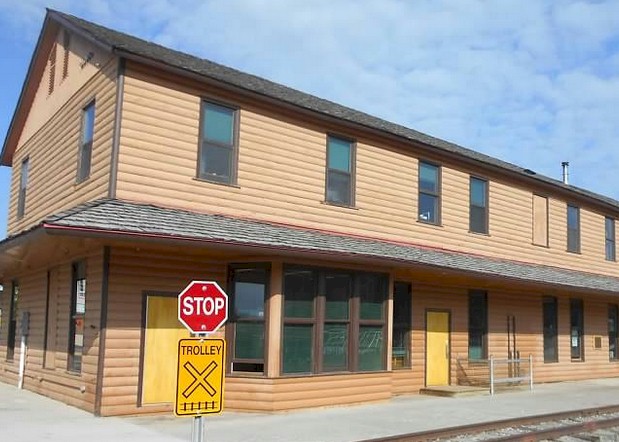
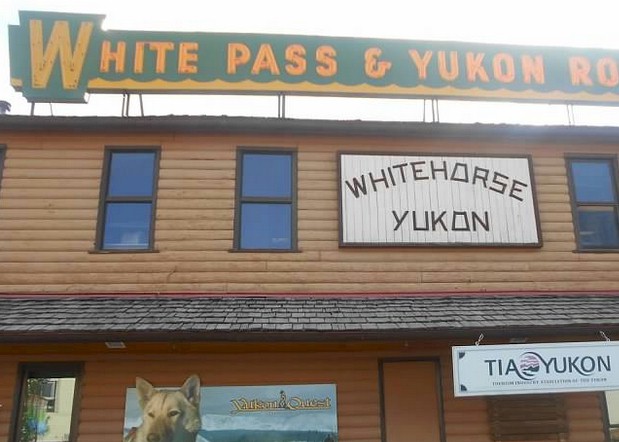
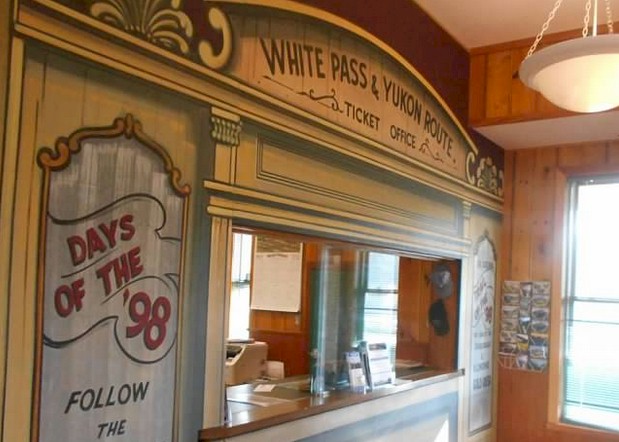
Photos of the White Pass & Yukon Route Train Station in Whitehorse, Yukon
(Robert Tabern photos)
Before departing Whitehorse we took a ride on the Whitehorse Waterfront Trolley. It
uses a single reconditioned trolley which carries tourists along
Whitehorse's waterfront along the Yukon River. It runs from Rotary
Peace Park, located on the south end of the city center, up to the
north end of the city center at Spook Creek Station. The car originally
served the trolley/streetcar system of Lisbon, Portugal, from 1925 to
1978. In 1978 it was sold by CCFL to a railway museum in Duluth,
Minnesota. It was sold to Whitehorse and restored by the Historical
Railway Restoration of Arlington, Washington. The trolley is a 3-foot
narrow gauge vehicle, and runs on a small portion of track built for
the White Pass and Yukon Route. It has a capacity of 24 passengers.
After
our short trip on the Whitehorse Waterfront Trolley, we headed to the
airport in Whitehorse, Yukon for a two hour Air Canada flight to
Vancouver, British Columbia. It was a fairly clear day and we were able
to see portions of Glacier Bay National Park from the airplane.
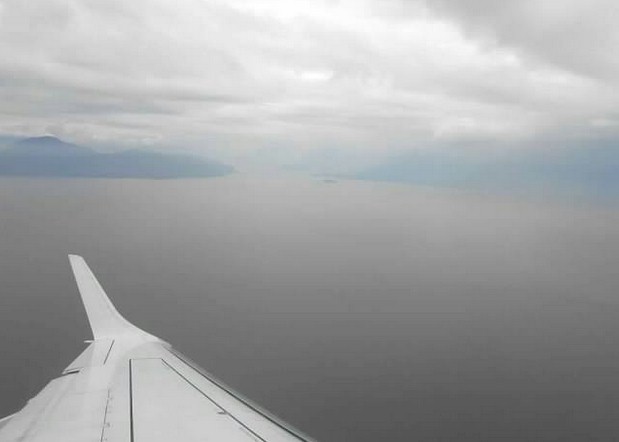
A view of Glacier Bay National Park and the Pacific Ocean from our flight between Whitehorse and Vancouver
(Robert Tabern photo)
Since
VIA's "Canadian" does not leave until the evening hours, we had most of
the day to explore around Vancouver, British Columbia. Neither of us
had been there before so this was a special treat. We got to spent the
day with our friend Mike Pace, who was along for the entire 15-day
trip, and also friends Robert Madison and Chris Wyatt, who came into
Vancouver for just the day to participate in a little exploring with us.
Since Mike, Chris, and Robert had all been to Vancouver before... they
let us choose what we wanted to see and do. Since it was a beautiful
late spring day, we decided to head up to Grouse Mountain, which is a
scenic overlook above Vancouver. We were able to reach Grouse Mountain
using the city bus system. From there, we took a gondola ride to near
the top of the mountain... but to reach the actual peak we had to take
a short ski lift ride. Besides beautiful views, there was a nice cafe
at the top... along with a grizzly bear habitat area, a wind turbine,
and a lumberjack show. We would highly recommend a visit to Grouse
Mountain, if you schedule allows. Several companies seemed to offer
expensive tourist packages to head up to Grouse Mountain from downtown
Vancover, but with a little planning you can use city buses and head
there on your own and save a significant amount of money. We would
recommend both the gondola ride and the ski lift ride to the top of the
mountain. You are over 4,000 feet above sea level at the top of the
mountain.
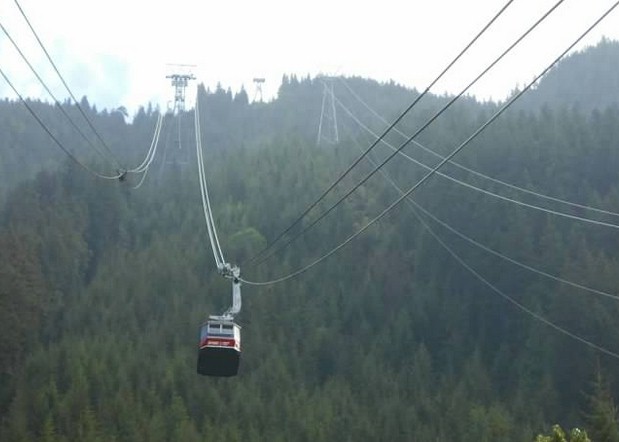
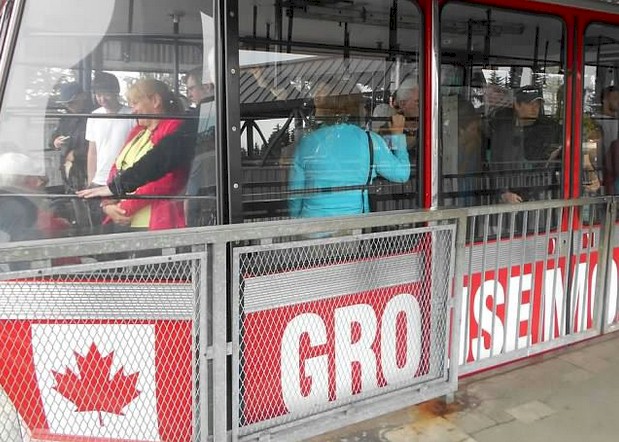
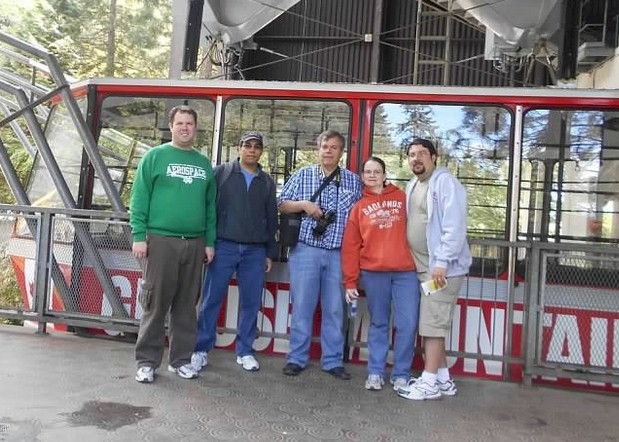
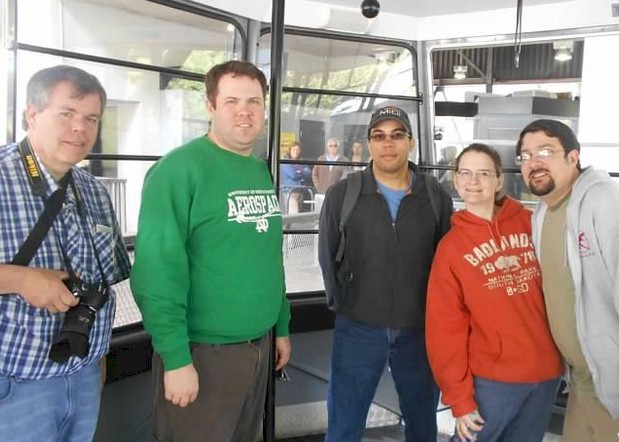
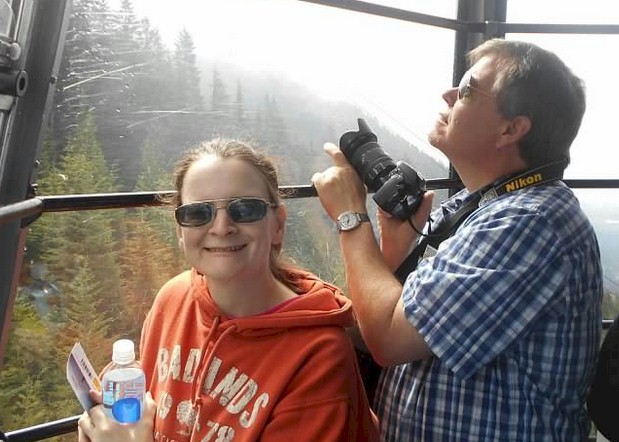
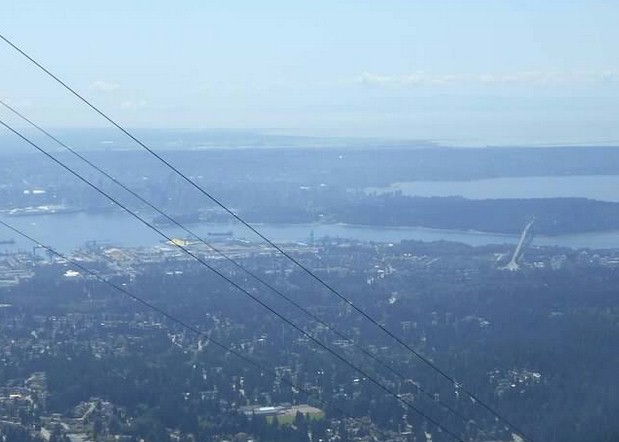
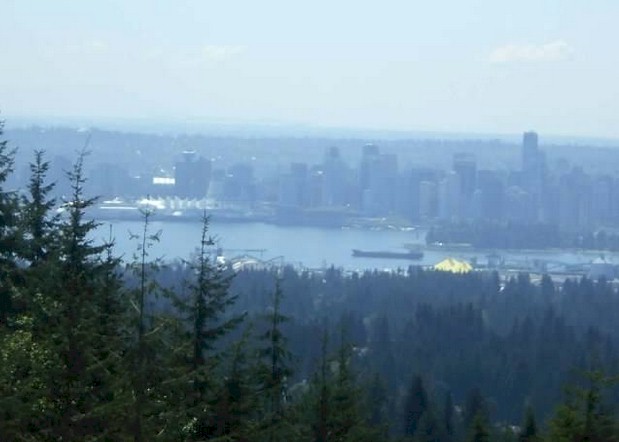
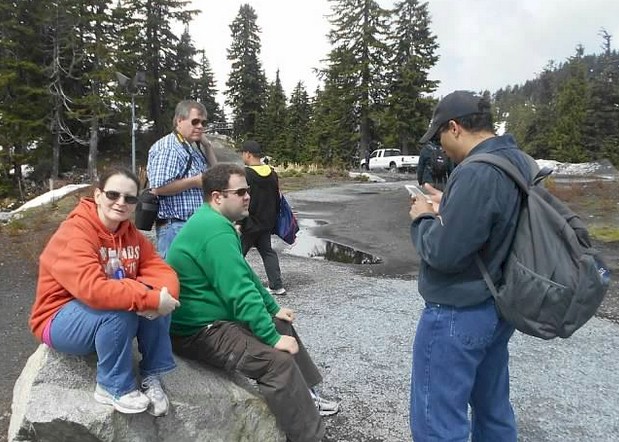
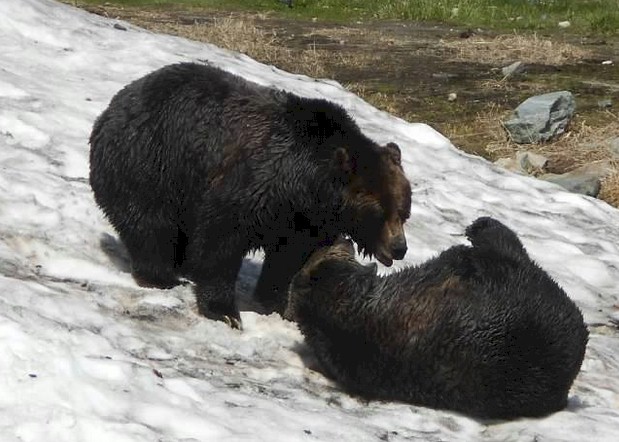
Various photos from Grouse Mountain, near Vancouver, British Columbia
(Robert Tabern photos)
Traveling from
Grouse Mountain back to downtown Vancouver, our friend Robert Madison
suggested that we take one of the city ferries (or as they call them "a
Sea Bus") for a portion of the way instead of taking the city bus. We
still have plenty of time before "The Canadian" left, so we decided to
go ahead with the idea. You can easily catch a ferry between Grouse
Mountain and downtown Vancouver by catching a regular city bus between
Grouse Mountain and the Lonsdale Quay SeaBus Terminal. We were glad we
decided to listen to Robert, because we were able to take some
beautiful photos of the city arriving on the ferry.
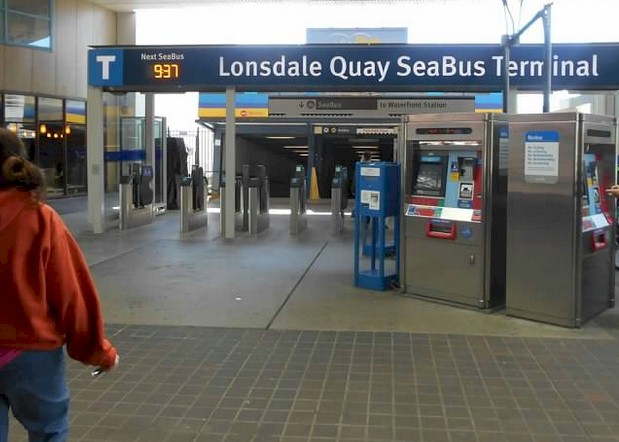
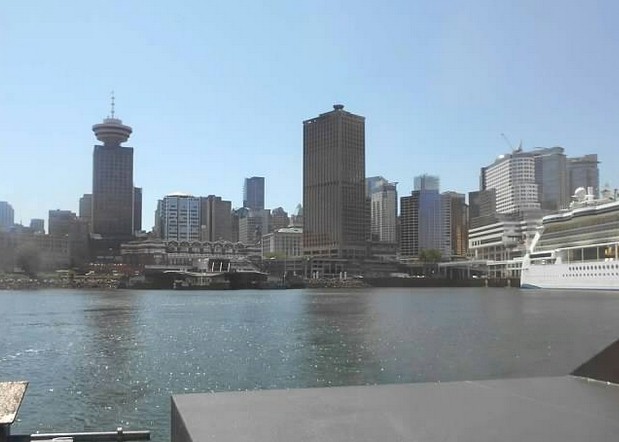
Travelers can consider taking the ferry back from Grouse Mountain instead of the city bus - the ferry is a lot more scenic!
(Robert Tabern photos)
We
made one more stop in downtown Vancouver before heading back to the VIA
Rail Station. We both wanted to get a glimpse of the 2010 Olympic
Cauldron, located on Jack Poole Plaza. According to a historical marker
at the site, "The Cauldron,
made of steel and glass, will be an everlasting symbol of the splendour
of the Games which occurred in the city between February 12th and 28th,
2010 amidst the beauty of the city, sky, Burrard Inlet and North Shore
mountains.
The Olympic Cauldron is symbolic with the commencement (Opening) of
the Games and since 1928, a continually burning cauldron has always been
located in the host city for any given Olympic Games." The tradition of the Olympic Cauldron and its flame started in 1928
in Amsterdam, and the torch relay in 1936 in Berlin. The Vancouver Olympic Cauldron became a permanent fixture in
Vancouver after the closing of the 2010 Olympic Winter
Games on the edge of the Burrard Inlet.

My friends Robert, Chris, and Mike, and my wife Kandace pose in front of the Olympic Cauldron in Vancouver
(Robert Tabern photo)
We
parted ways with Robert M. and Chris and headed over to the VIA Rail
Station in Vancouver. Mike and us decided to check-in to their First
Class Lounge and spend some time relaxing before our upcoming long rail
journey across Canada. This would be Kandace's first trip on "The
Canadian", while Robert had done one trip prior (in September 2011)
with Mike from Toronto to Jasper... and then up to Prince Rupert on the
"Skeena". There were some snacks and free beverages in the lounge.
However, since most people go in sleeper class on "The Canadian", the
lounge was quite full of people and there wasn't a lot of room. Since
it was a nice day, we decided to sit in the outdoor portion of the
lounge, in a fenced-in area besides the tracks, which a lot of people
didn't seem to know about. While waiting for the train, we noticed that
"The Canadian" was so long it was actually broken into two separate
sections that would be put together before departing. The train was
over 20 cars long! If the train wasn't broken in two parts, it would have been a long walk potentially for
someone between the station and their train car, but more importantly, the platforms at the
Vancouver station were not long enough to accomodate a 20-car train.
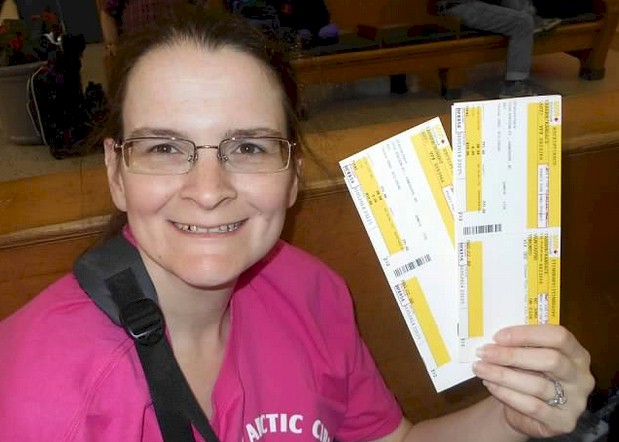
Kandace holds up our tickets for our trip from Vancouver to Toronto on VIA's "The Canadian"
(Robert Tabern photo)

The entrance of the First Class Panorama Lounge at the Vancouver VIA Station
(Robert Tabern photo)
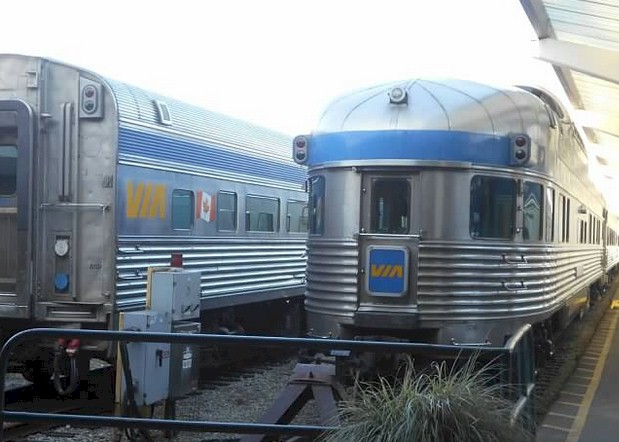
"The
Canadian" is too long for the platform in Vancouver, so it actually had
to be broken in two sections
(Robert Tabern photo)
While
there are many ways to write an article about one's experience of
traveling on "The Canadian" for three days and four nights between
Vancouver and Toronto... for this particular blog... we are choosing to
focus on the different type of railcars that we got to experience. We
are planning a repeat trip on "The Canadian" in 2016 and hope to write
future articles about other aspects of the trip.
We
begin with the locomotives. Unfortunately, there didn't seem to be a
lot of places to photograph them. Part of the reason was our sleeping
car was at the very back of the train, and there really wasn't time at
many of the smaller "smoke stops" to walk all the way up to the
locomotive and take pictures. Maybe next time we'll plan ahead and walk
up to one of the front sleepers and get off the train there ahead of
the longer stops. None-the-less, we still had a couple of occasions
where we were able to walk up to the front of the train consist to see
the rebuilt EMD F40PH-3. Our lead unit number was #6436 and it was
re-built by VIA in January 2010.


\
Our train featured re-built P40 engine #6436; this was the May 30, 2014 depature out of Vancouver
(Robert Tabern photo)
Next
up was a VIA Business Class passenger car which appeared to be
deadheading to Toronto, but was also being used in place of a baggage
car for the entire journey. Business Class cars are really only used on
busy VIA Corridor services between Windsor and Montreal. Passengers
were not allowed to go in this car, as it contained many bags. We're
not sure what happened to the actual baggage car we should have had on
the train.
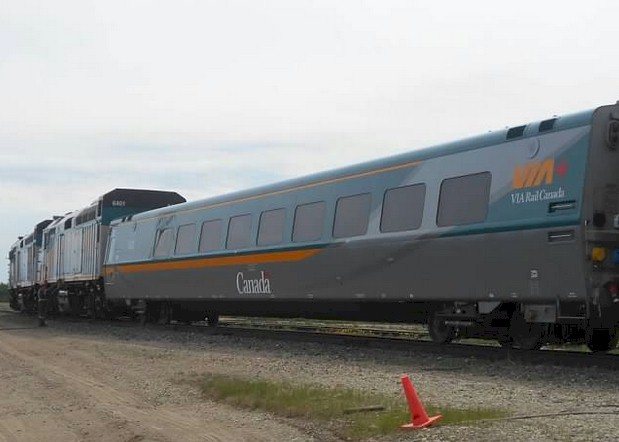 A VIA Business Class Car that appeared to be deadheading to Toronto also doubled as our baggage car
A VIA Business Class Car that appeared to be deadheading to Toronto also doubled as our baggage car
(Robert Tabern photo)
We
now move on to the coach cars. If you have never traveled "The
Canadian" and have only ridden Amtrak, you may be surprised to know
that very few people travel in coach on "The Canadian". In fact, while
there were nearly 15 sleeping cars on our train consist for the May 30,
2014 depature out of Vancouver, there were just 2 lonely coach cars at
the front of the train. I guess when you are going to be on the train
for four nights, you probably want something a little nicer than
coach? Or, maybe people who have the time to take such a long
train ride are mostly retired and can afford a little nicer
accomodations. Anyway, yes, there were just two coaches on our train
and they were not very full at any point in our journey. While coach
passengers had to pay for their meals, they still had access to one of
the four dome cars on the train. So, if you are looking for an
economical way to ride "The Canadian" and still have a chance to ride
in one of the classic dome cars, coach might be the option for you. But
again, what was interesting is that the majority of Amtrak passengers
seem to travel coach - while the majority of VIA passengers, at least
on "The Canadian" decide to go in a sleeping car.
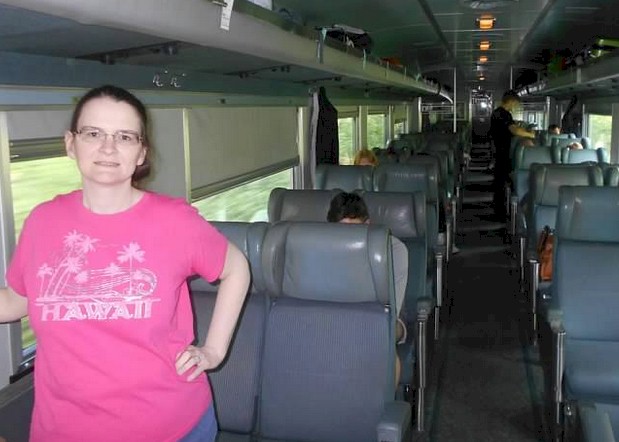
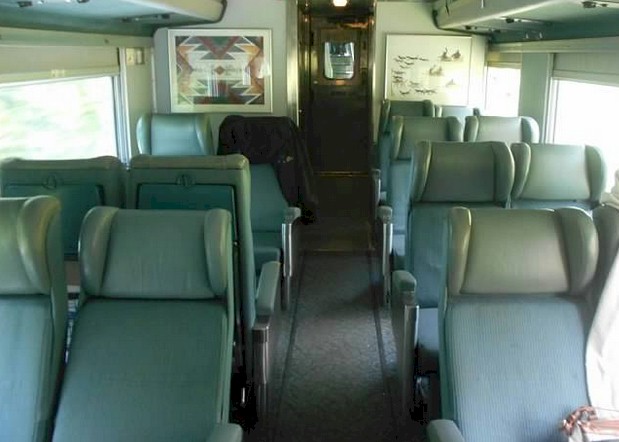 A look at the coach accomodations on "The Canadian"
A look at the coach accomodations on "The Canadian"
(Robert Tabern photo)
From
coach class... we move to the sleepers. There are two different types
of sleeping cars being used by VIA on "The Canadian" - the Chateau
Sleeping Car and the Manor Sleeping Car.
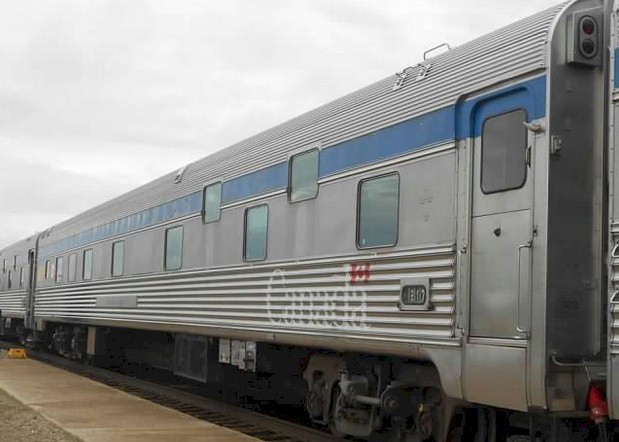 A Chateau Sleeping Car
A Chateau Sleeping Car
(Robert Tabern photo)
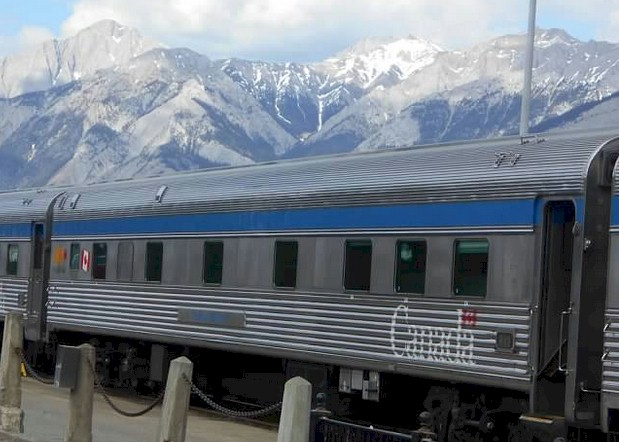 A Manor Sleeping Car
A Manor Sleeping Car
(Robert Tabern photo)
The
Chateau sleeping cars were built between July and November 1954 by the
Budd Car Company and AMF; they were acquired by VIA in 1978. They are
numbered 8201 to 8229, and VIA currently has 29 of them in their fleet.
They feature three sets of upper/lower berths, eight roomettes, three
double bedrooms, two common bathrooms, and a common shower.The
roomettes in the "Chateau" series sleepers are unchanged (except, of
course, for carpeting and wall-covering) from the way they were
delivered to the Canadian Pacific in 1954. Four of the eight are
"lower" roomettes and the other four are "upper." The only significant
change to the sleepers (both the "Chateau" and "Manor" series) is the
replacement of one open berth section with a shower and changing room.
The Manor sleeping cars were
built between November 1954 and April 1955 by the Budd Car Company and
AMF; they were also acquired by VIA in 1978. They are numbered 8301 to
8342, and VIA currently has 40 of the them in their fleet. They feature
three sets of upper/lower births, four roomettes, six double bedrooms,
two common bathrooms, and a common shower. The photos below show you
examples of some of your rooming options if you want to take a sleeping
car on "The Canadian".
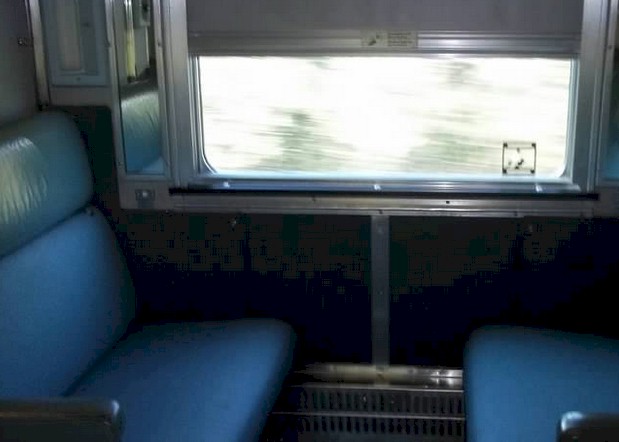
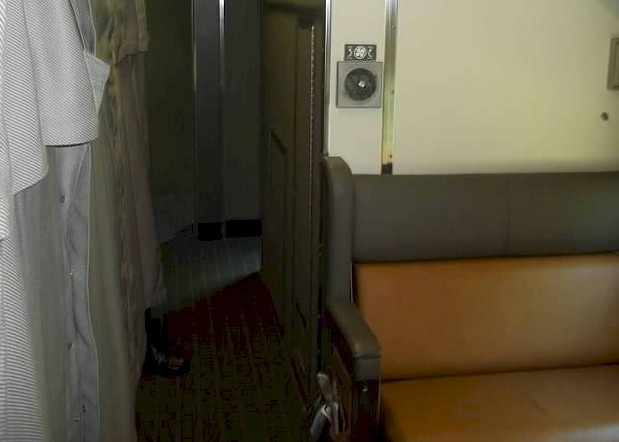
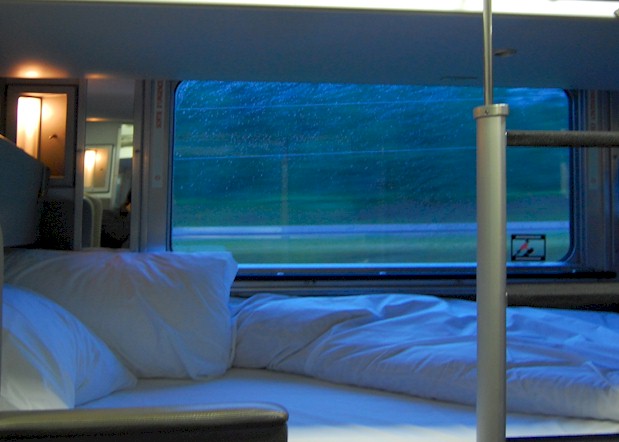 Upper and Lower Berth Accomodations on VIA's "The Canadian"
Upper and Lower Berth Accomodations on VIA's "The Canadian"
(Robert Tabern photos & VIA Rail Photo)
By
using upper and lower berths, you are choosing to go the most
economical way to travel in a sleeping car. As you can see from the
first photo, you are giving up the privacy of a room during the day, as
there is no door separating you from people walking by in the hallway.
At night, the seats fold together to form the lower bed, while the
upper bed comes out of the wall. At night, there is a curtain that
separates you from the hallway and people walking by. The advantages of
going in an upper or lower berth over coach is that you get an actual
bed for the four night trip across Canada and can lay flat. And, yes,
all of your meals are included if you choose to go in an upper or lower
berth, which can mean big savings! Plus, while coach passengers
only have access to one dome car... passengers who choose the upper or
lower berth option, have access to all four dome cars on the train,
including the round-ended observation car/dome at the end of the train,
called the Park Car.
Even
though we chose more luxurious accomodations for this particular train
trip we did in May/June 2014, we are seriously considering just going
with an upper and lower bunk for our possible trip in 2016. First, we
found ourselves spending most of the day, each day, in one of the four
dome/lounge cars. We used our bedroom very little. Second, the upper
and lower berths are significantly less expensive than one of the
actual bedrooms... which might mean we would be able to afford to take
"The Canadian" more often in future years. Finally, one little known
fact is that the beds formed by the bunks are wider than even those in
the bedroom. There is something VIA won't openly admit! But yes,
while in our bedroom we could only fit one person in a bed (Robert got
the upper and Kandace got the lower), we could have slept next to each
other comfortably if we chose to go with an upper and lower bunk. We
probably would have just used the upper bunk to store our luggage. And,
considering we spent most of the day in the dome/lounge cars, if/when
we do the bunks in 2016, we probably would just request the bunks to
stay beds throughout the day. Our only reservations are Robert is a
light sleeper and wonders if the curtain would prevent noise and light
from getting in the sleeping area... and you do not have private
bathrooms with the upper and lower bunk areas.
Besides
getting a room in a Chateau or Manor Sleeper, you may be lucky enough
to score sleeping car accomodations in the Park Car, which is the
round-ended observation car located at the rear of the train. There are
three double bedrooms and one triple bedroom (Bedroom "A") located
here. We booked early and got a great deal on this - the largest and
most luxurious accomodations on the train. Here are a few photos from
our room in the Park Car:
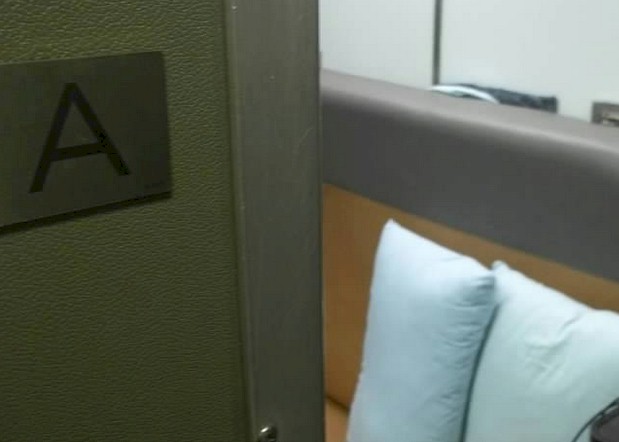
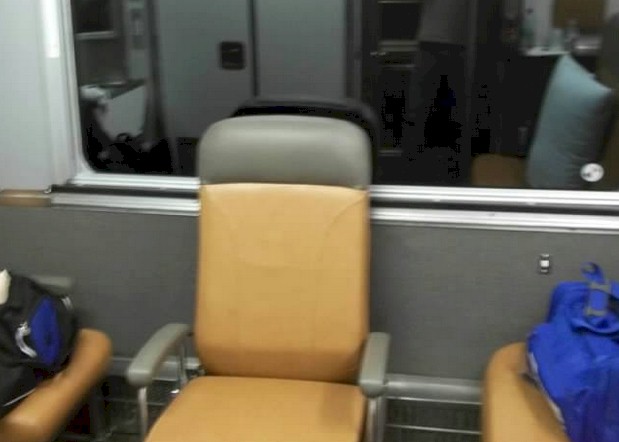
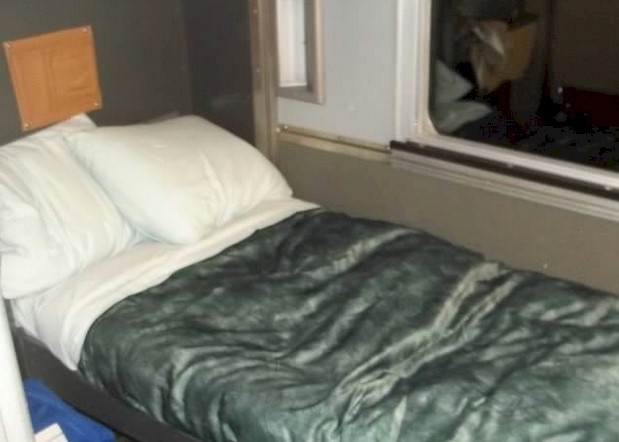
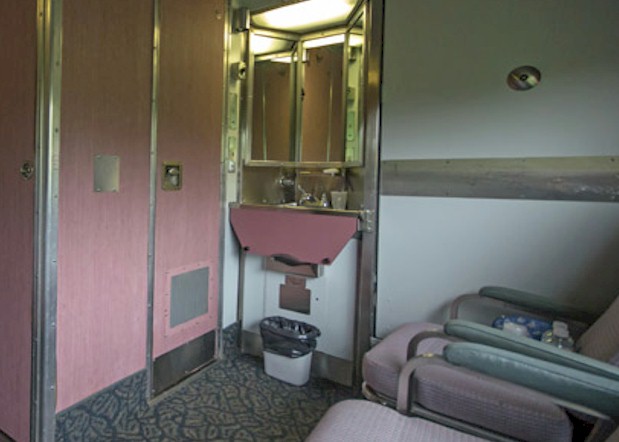
Our bedroom in the park car on VIA's Canadian
(Robert Tabern photos)
Now
that we have the coach and sleeping car accomodations covered, let's
take a look at some of the other cars on "The Canadian"; we will start
with the observation/dome cars. There are a total of four dome cars on
the typical summer consist. Three are called "Skyline" cars and
feature a lounge/cafe on the bottom level and a dome on the upper
level. One "Skyline" car is for coach passengers and the other two are
open to sleeping car passengers. From time-to-time, there are special
activities in these cars, including movies, lectures or talks about the
area of Canada the train is passing through, wine and beer tastings,
and special souvenier sale hours. Here a few photos of the "Skyline"
observation cars.
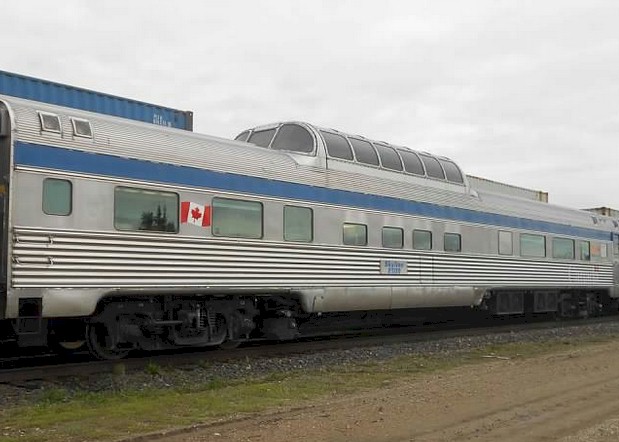
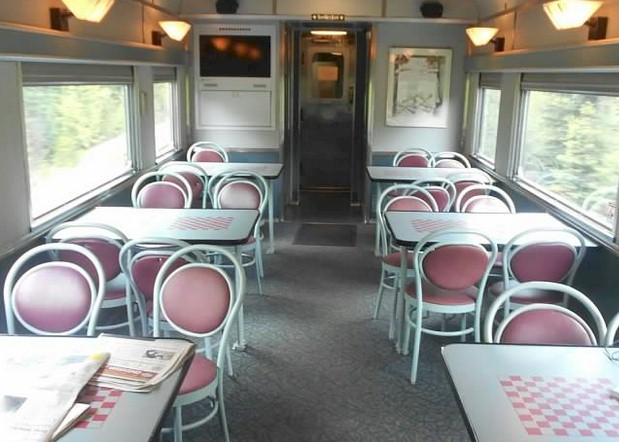
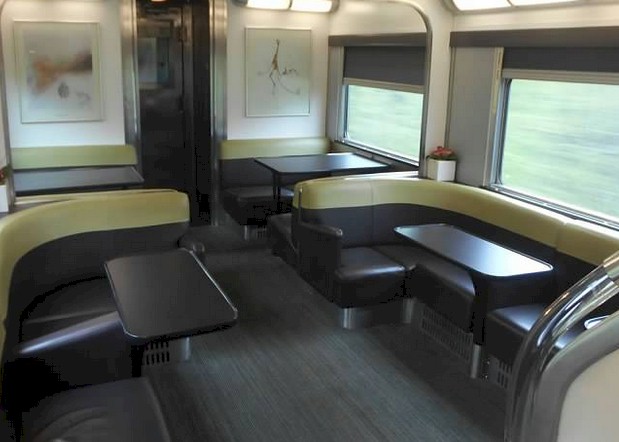
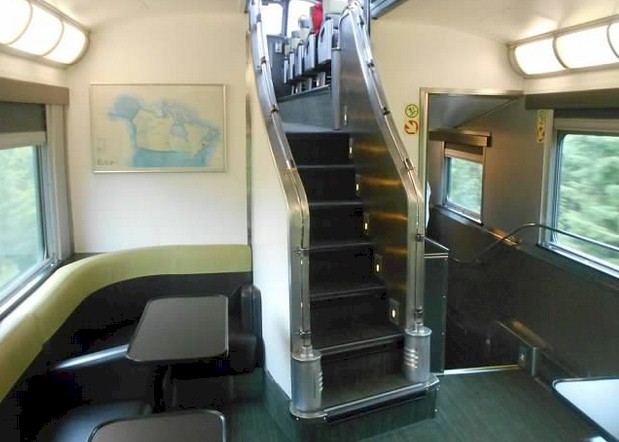
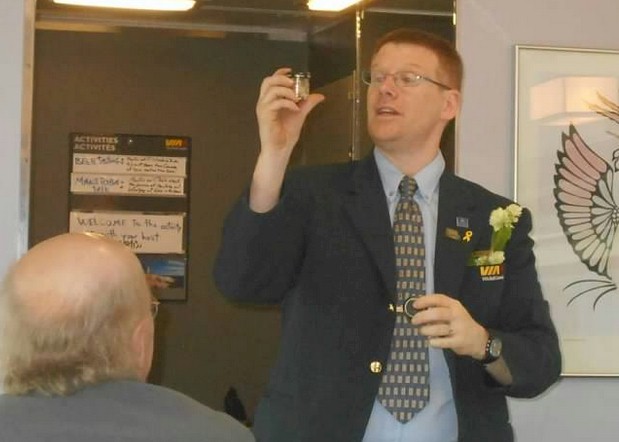
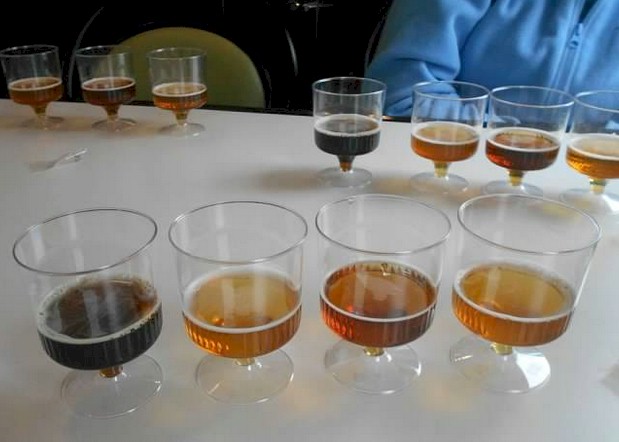
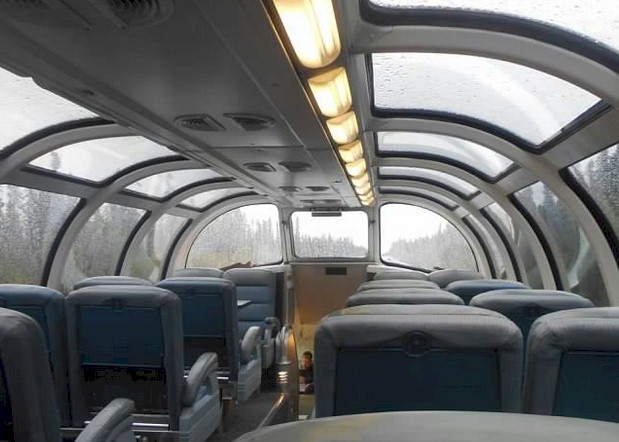
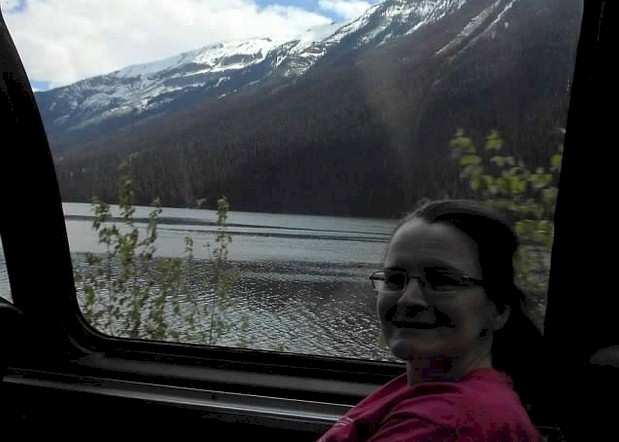 Various photos taken in the "Skyline" observation car aboard "The Canadian"
Various photos taken in the "Skyline" observation car aboard "The Canadian"
(Robert Tabern photos)
The
fourth lounge/dome car on "The Canadian" is called the Park Car and
it's located at the very rear of the train. As we mentioned a few
paragraphs ago, we actually stayed in one of four bedrooms located on
the lowel level of the Park Car. Again, because there are dozens of
other bedrooms on the train, these are sometimes hard to come by and
have to generally be reserved many months in advance. Besides these
four rooms, there is a lounge and bar area and a round-end observation
area on the first level. There is also a dome with seating for 24 up
above. Each of these cars is named for a national park in Canada. This
was the most elegant of the four lounge cars and is where we spent the
majority of the time on the train. Our car was named "Tremblant Park".
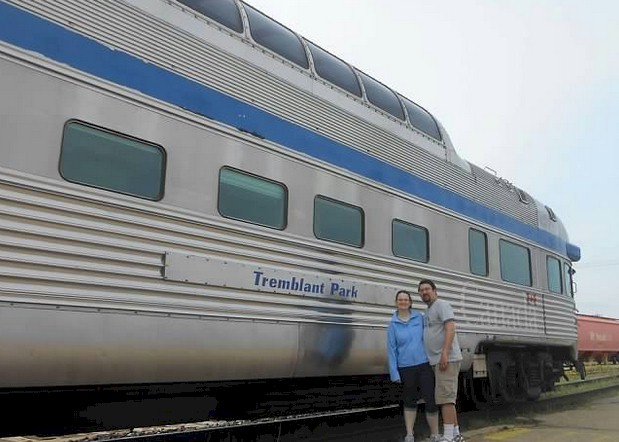
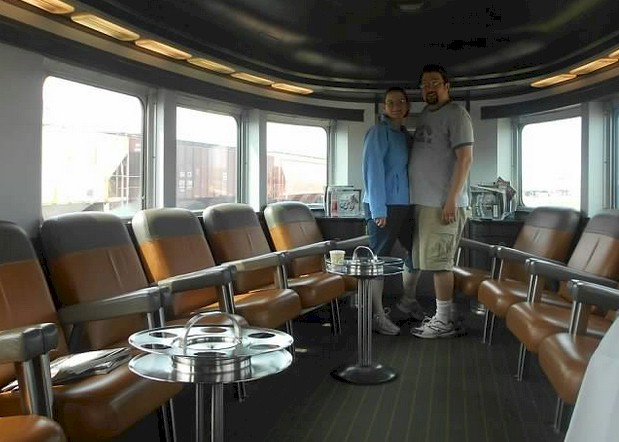
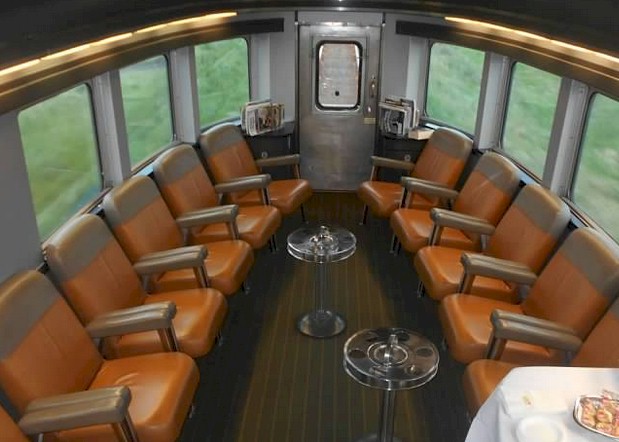
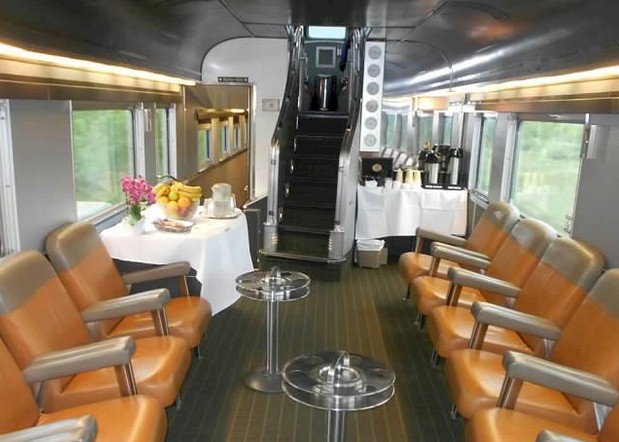
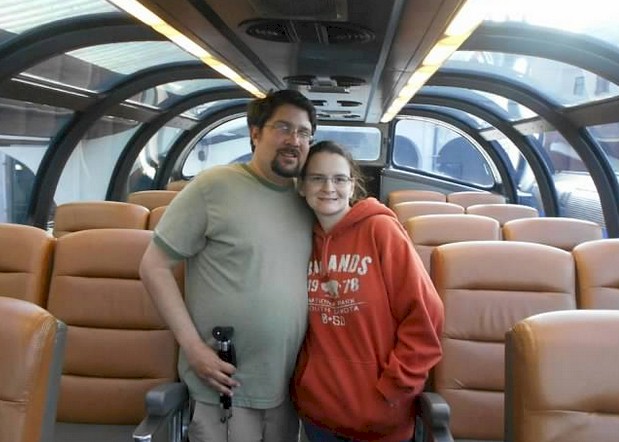
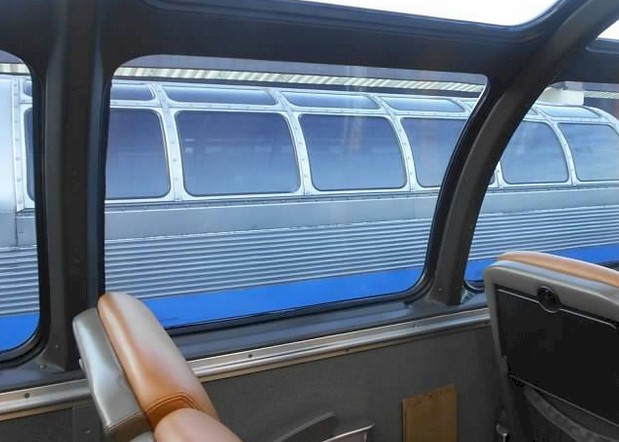
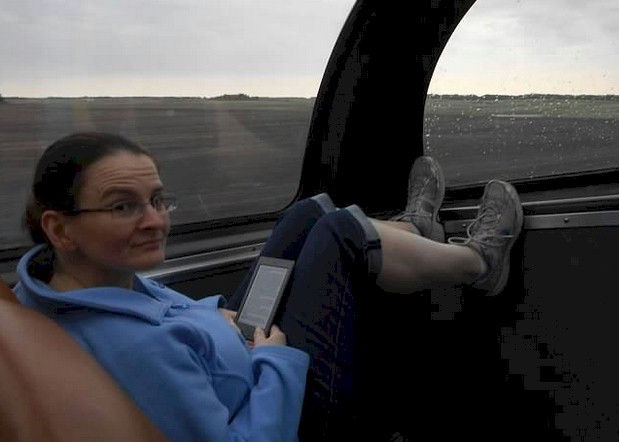
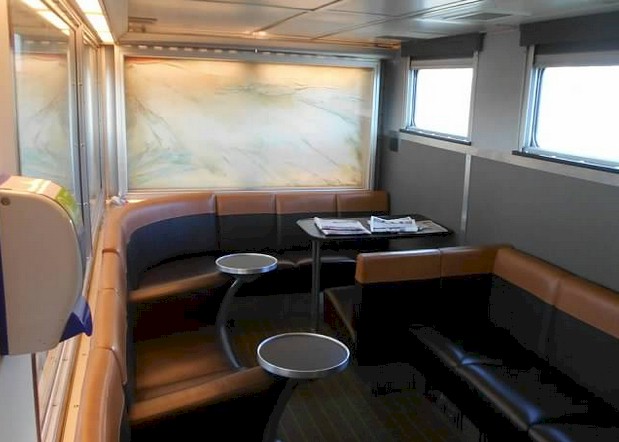 Various photos taken in the Park Car aboard "The Canadian"
Various photos taken in the Park Car aboard "The Canadian"
(Robert Tabern photos)
And
yes, if the three dome/lounge "Skyline" cars and the dome/lounge Park
Car was not enough for you, VIA runs what is called a "Panorama Car"
between Vancouver and Edmonton. Apparently VIA only had three of these
cars and runs them on the most spectacular scenery along the route...
which is through the Rockies between Vancouver and Edmonton. It was
comproable to Amtrak's Sightseer Lounge Car, except this was a
single-level car and had even larger windows. Seating in the "Panorama
Car" was open to sleeping car passengers only, on a first-come,
first-serve basis.
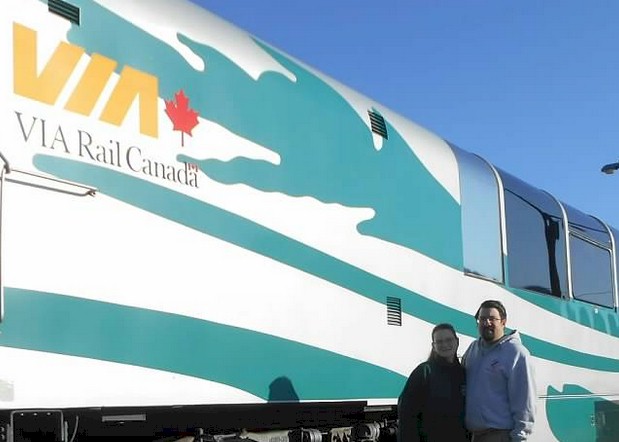
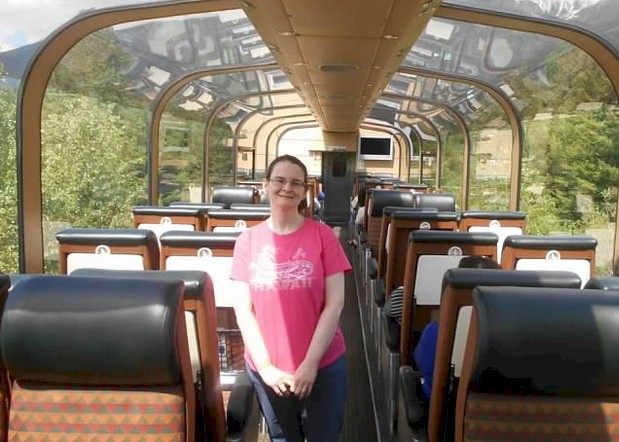 Various photos taken on board the "Panorama Car" between Vancouver and Edmonton on VIA's "Canadian"
Various photos taken on board the "Panorama Car" between Vancouver and Edmonton on VIA's "Canadian"
Now
you have seen the coach, sleepers, and lounge areas of the train. Not
to be outdone were the dining cars. During the time of the year we
went, there were two dining cars on the train... an "A Diner" and a "B
Diner". People who were towards the front of the train were assigned in
the "A Diner" and people towards the rear of the train were assigned
the "B Diner". There were generally three seating times that were about
90 to 120 minutes apart from one another. The food was amazing and much
better than anything you can find on Amtrak, in our opinion. Below is a
sampling of photos from the dining car. Note that they actually have
real chairs, and not just booths. The real amazing thing was - if they
had leftovers of something and you wanted a second helping - they would
really accommodate you. I think every morning we had extra bacon!!!
Kandace tried lamb for the first time ever on "The Canadian" and loved
it!! Yum!! Again, meals are complimentary to sleeping car
passengers and must be paid for if you are traveling in coach.
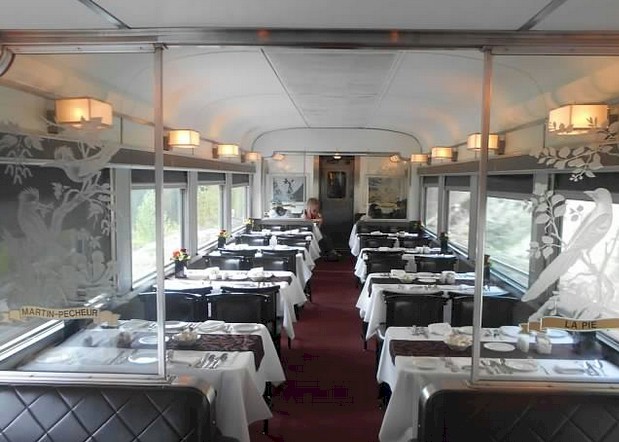
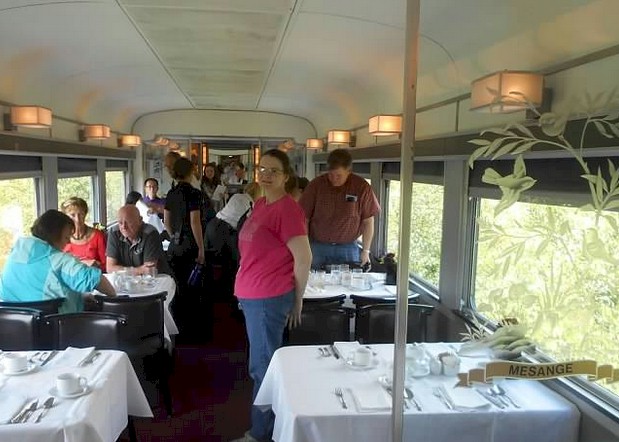
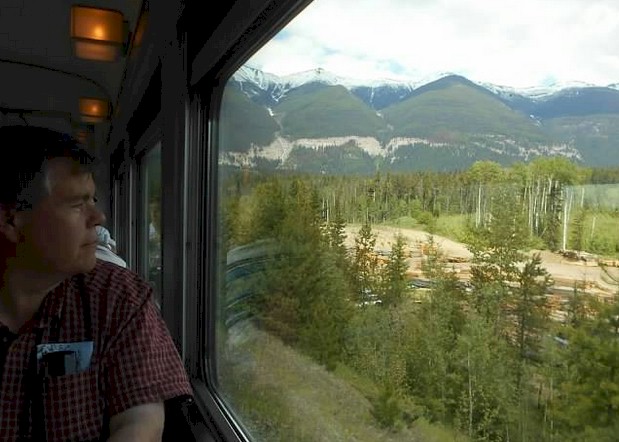
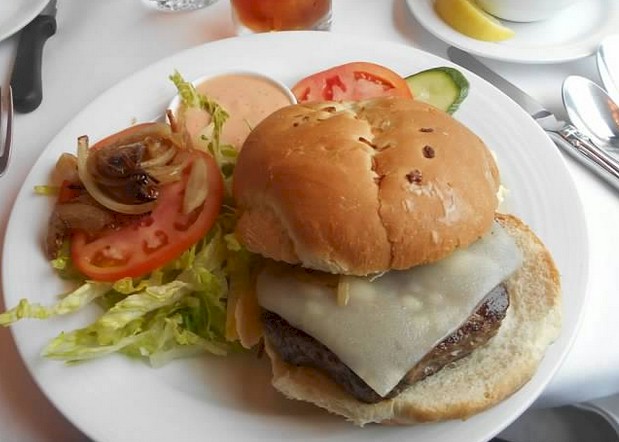
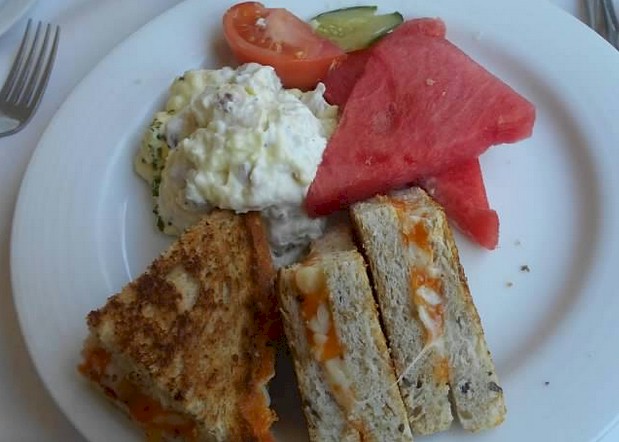 Various photos taken of our lunch one afternoon aboard "The Canadian"
(Robert Tabern photos)
Various photos taken of our lunch one afternoon aboard "The Canadian"
(Robert Tabern photos)
Below are a few other random photos from our trip.
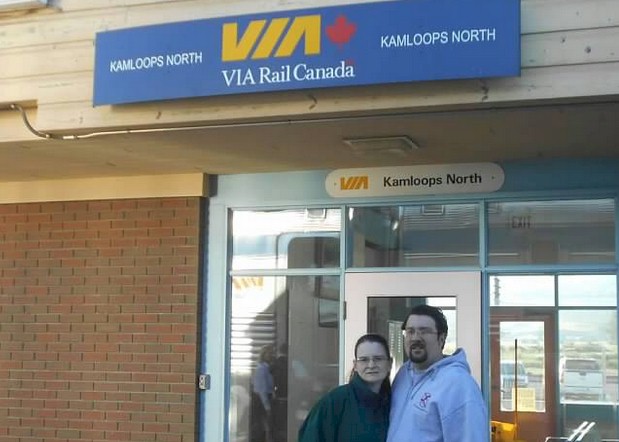 Robert & Kandace pose for a picture together during a "smoke stop" at the Kamloops North VIA Station
(Mike Pace photo)
Robert & Kandace pose for a picture together during a "smoke stop" at the Kamloops North VIA Station
(Mike Pace photo)
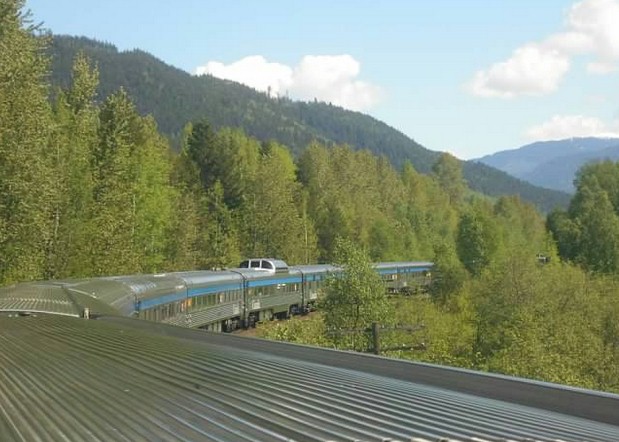
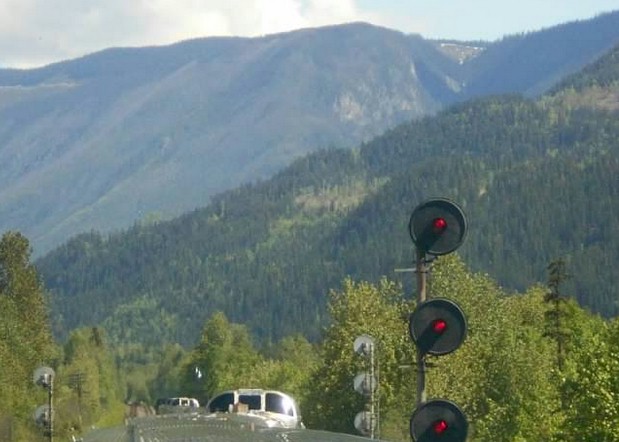
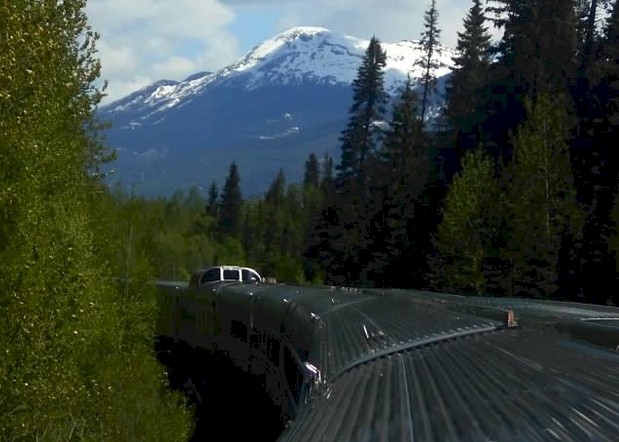
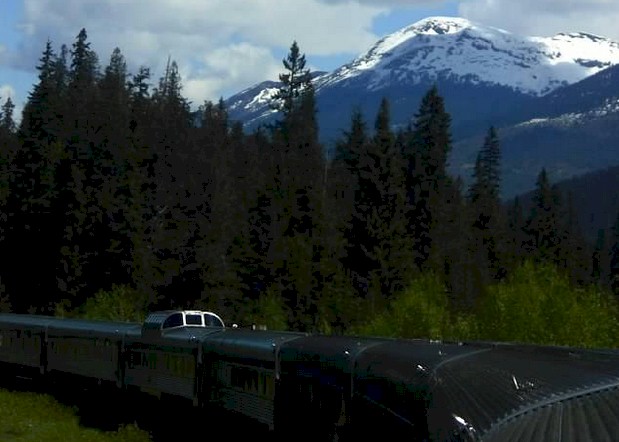 Various photos taken from the Park Car aboard "The Canadian" while going through the Rocky Mountains
Various photos taken from the Park Car aboard "The Canadian" while going through the Rocky Mountains
(Robert & Kandace Tabern photos)
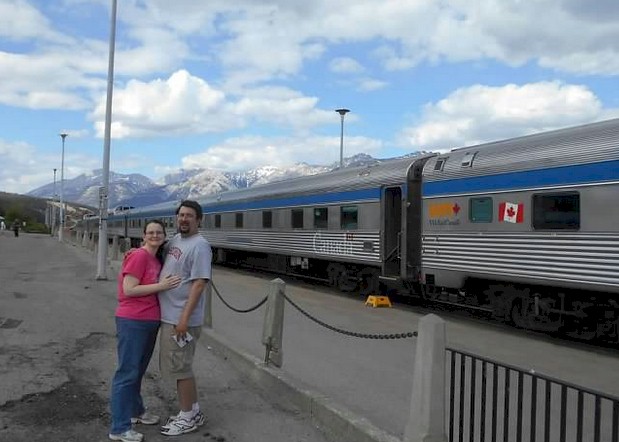
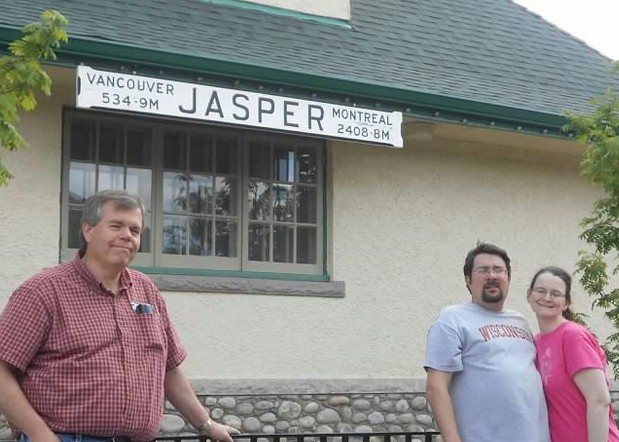
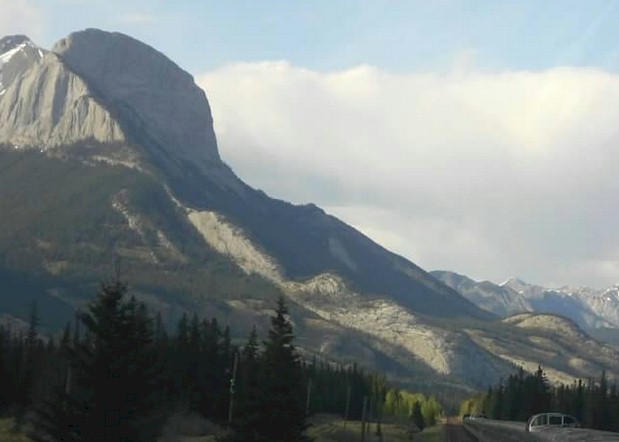
One of the longer stops of the journey is in Jasper, Alberta; passengers are given about two hours to walk around town
(Robert Tabern photos)
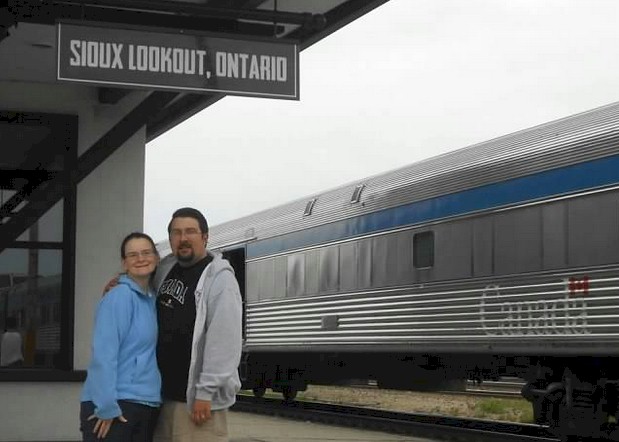
Another quick "smoke stop" on the route of the Canadian is Sioux Lookout, Ontario
Three
days and four nights after leaving Vancouver, passengers arrive in
Toronto, Ontario - the ending point of the trip. Passengers can
continue traveling east by connecting on a regional VIA Train between
Toronto and Montreal and then taking the overnight train called "The
Ocean" over to Halifax, Nova Scotia. Due to taking 15 days already for
this vacation, we had to begin heading home. In Toronto, we rented a
car and drove to Niagara Falls. It's about a 2 hour drive from Toronto,
depending on what kind of traffic you encounter. We found that numerous
rental car companies wanted to charge a huge free for a one-way rental
from Toronto to New York. After doing some research, we found Avis to
be the most affordable. Maybe the large fee had to do with taking a
Canadian car across the border and into the United States?
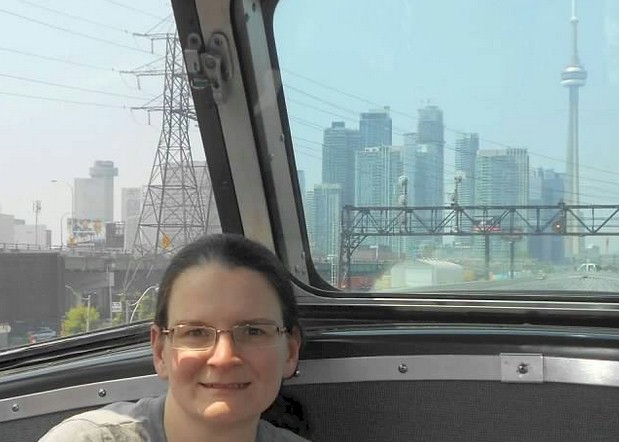 Kandace knowns her journey on "The Canadian" is just about up, with the Toronto skyline coming into view on the dome car
Kandace knowns her journey on "The Canadian" is just about up, with the Toronto skyline coming into view on the dome car
(Robert Tabern photo)
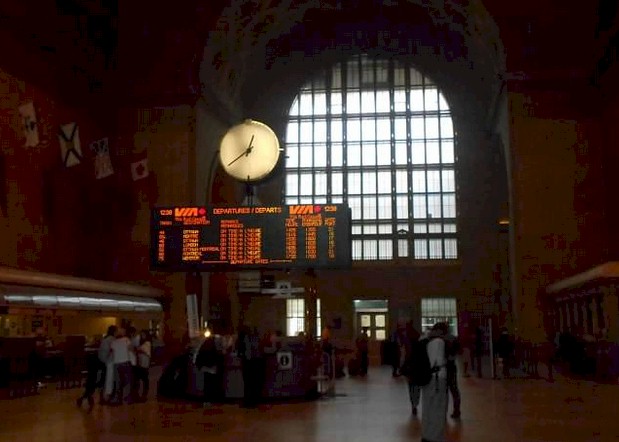
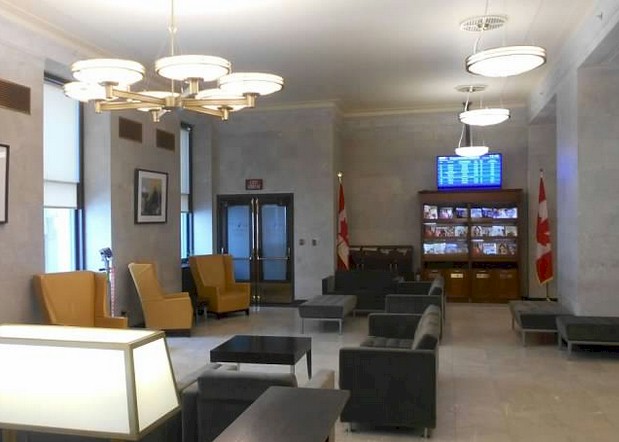
A view of the Toronto VIA station (top photo) and the First Class Lounge (bottom photo) at VIA Toronto
(Robert Tabern photos)
We
figured Niagara Falls would be a fitting last stop on our trip that
took up nearly half a month and covered nearly 10,000 miles of ground.
We viewed the Falls from both the Canadian and American sides, and
ended up taking a boat ride to the base of the falls.
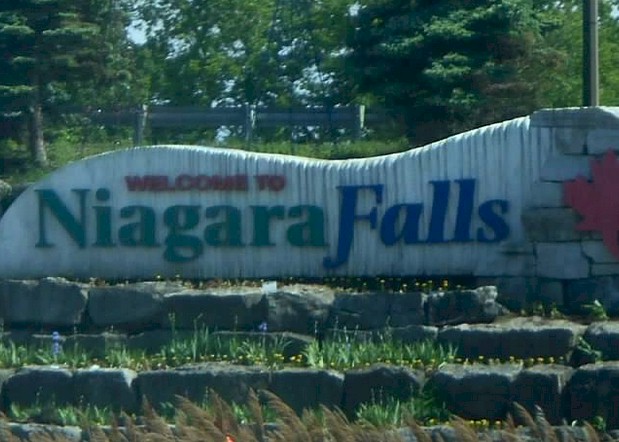
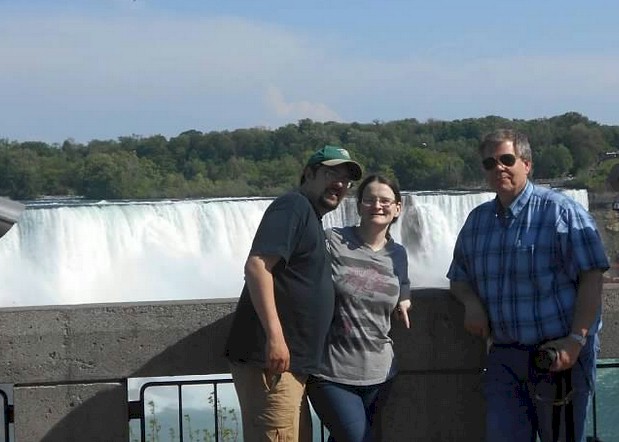
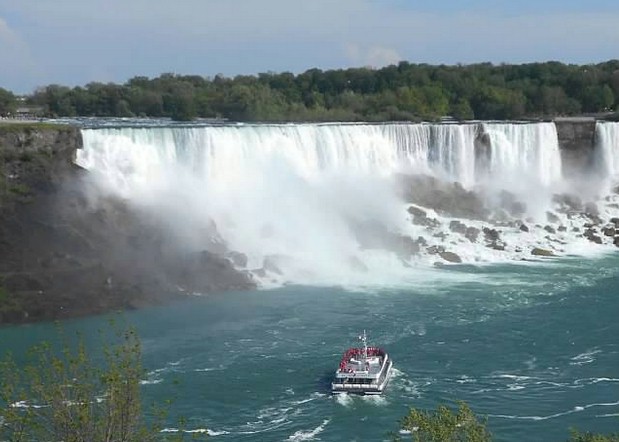
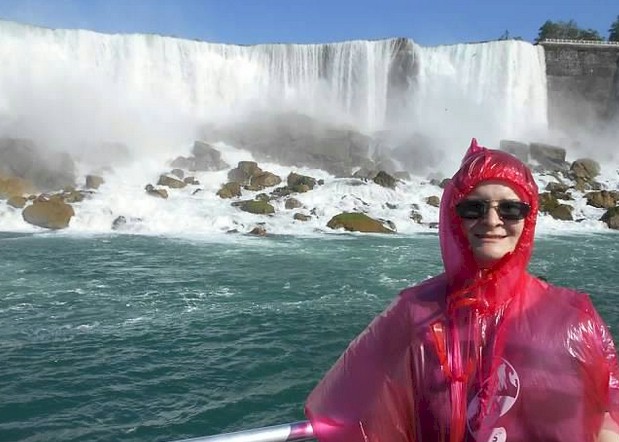 Various photos from our quick side-trip to Niagara Falls
(Robert Tabern photos)
Various photos from our quick side-trip to Niagara Falls
(Robert Tabern photos)
After
going through U.S. Customs, we began to head over to Rochester, New
York. Instead of taking Interstate 90 all the way, we took a scenic
drive along the coast of Lake Ontario. This led us to a small state
park and lighthouse, which was worth a stopover. It's called Golden
Hill State Park.
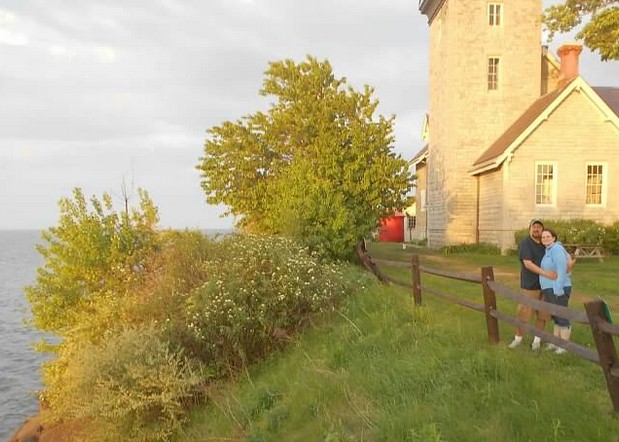 Robert & Kandace post for a picture at Golden Hill State Park; note the lighthouse and Lake Ontario
(Mike Pace photo)
Robert & Kandace post for a picture at Golden Hill State Park; note the lighthouse and Lake Ontario
(Mike Pace photo)
In
Rochester that night, we parted ways with our friend and traveling
companion - Mike. He was spending the night in a hotel in Rochester to
catch the "Lake Shore Limited" home to Boston in the morning. We headed
over to the Amtrak station in Rochester to catch the "Lake Shore
Limited", which was delayed by several hours, back home to Chicago.
We
hope you enjoyed the third and final part of our journey across Alaska
and
Canada. Hopefully this will inspire you to plan your own journey on the
Alaska Railroad, the White Pass & Yukon, or VIA's "The Canadian" --
or maybe all three!! We probably won't be going back to Alaska
anytime soon, but are hoping to do some ride on the "The Canadian" in
2016.
